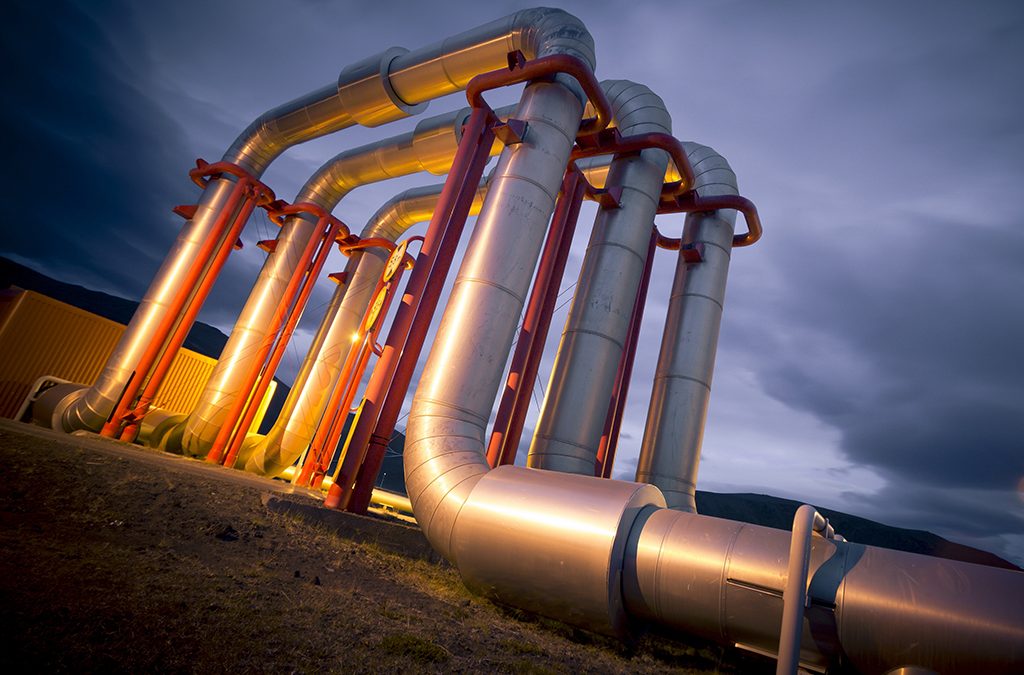
by siteadmin | Jun 2, 2011 | Portfolio Item
INDUSTRY: Chemical Processing
APPLICATION: Coating of Chemical Flash Drums
PROBLEM:
 A major chemical processing plant was experiencing severe corrosion on carbon steel flash drums resulting from hydrochloric and hydrofluoric acids. The rate of corrosion was approximately 20 mils per week. The temperatures inside the drums ranged from ambient to 100 deg F. The acids were corroding the inside of the drum and causing leaks. Due to these leaks the drums were only lasting in service for approximately 4-6 months.
A major chemical processing plant was experiencing severe corrosion on carbon steel flash drums resulting from hydrochloric and hydrofluoric acids. The rate of corrosion was approximately 20 mils per week. The temperatures inside the drums ranged from ambient to 100 deg F. The acids were corroding the inside of the drum and causing leaks. Due to these leaks the drums were only lasting in service for approximately 4-6 months.
SOLUTION: Impreglon 216
The solution to this problem came when Southwest Impreglon’s technical staff recommended the Impreglon 216. The Impreglon 216 coating was applied @ 30-40 mils thick per side, creating a non porous film, to the ID of the drum. The coating was then spark tested @ 3000 volts DC to check for pinholes. As an added benefit Southwest Impreglon also recommended coating the outside of the drum with a 3 coat epoxy paint system consisting of a zinc base coat, an epoxy mid coat and a urethane topcoat
CONCLUSION:
With the addition of the Impreglon 216 coating on the ID of the drum and the 3 coat epoxy system on the exterior of the drum the parts that had previously only lasted 4-6 months in service now have a life span of about 5 years. The customer was so happy with this system that they are currently evaluating additional parts for this coating system.

by siteadmin | Jun 2, 2011 | Portfolio Item
INDUSTRY: Chemical Processing
APPLICATION: Chemical Drip Pans & Piping
PROBLEM:
 A major chemical processing plant was having problems with its chemical drip pans and steel piping. The plant is involved in the manufacturing of a variety of petroleum products.
A major chemical processing plant was having problems with its chemical drip pans and steel piping. The plant is involved in the manufacturing of a variety of petroleum products.
One such product produced by reacting petroleum distillates with oleum, an extremely corrosive solution of free sulfur trioxide (SO3)in anhydrous concentrated sulfuric acid (H2SO4).
The spent acid from the sulfonation process was a heavy oily liquid containing up to 95% anhydrous H2SO4 and was corroding away the piping and chemical drip pans used in transferring the acid to storage tanks.
Of particular concern were the problems that developed when the leaks started developing around the flanges and sulfuric acid began to drip. Although made from high performance alloys, the acid was attacking the alloy after being in service for less than one year. Not only from the standpoint of safety, but also the environmental impact, this was unacceptable.
SOLUTION: Impreglon 216
The solution to the problem came when Southwest Impreglon, Inc. recommended the application of its Impreglon 216 coating. The coating was applied to all the internal wetted surface areas of the piping and chemical drip pans. The coating was applied (20-30) mils thick and holiday spark tested @ 5000 volts D.C. to certify that there was no pinhole porosity in the coating. Both the coated piping and drip pans were installed and put back into service.
CONCLUSION:
Both the piping and drip pans were inspected one year later at the regularly scheduled maintenance. Neither the piping or the drip pans showed any signs of corrosion. As of this date, and almost 2 years later, the equipment is stillin service with little or no signs of corrosion. Since that time, the customer has specified for all the drip pans and associated piping to be coated with Impreglon 216.

by siteadmin | Jun 2, 2011 | Portfolio Item
INDUSTRY: Chemical Processing
APPLICATION: Filter Housing
PROBLEM:
 A major chemical processing plant was experiencing problems with its filter housings and associated piping used in the manufacturing of zirconium.
A major chemical processing plant was experiencing problems with its filter housings and associated piping used in the manufacturing of zirconium.
In one of the process steps for the manufacturing of zirconium, they were combining sodium hydroxide with chlorine to produce sodium hypochlorite. Filtering systems were being used to remove chlorine from the gaseous stream generated during production. The chlorine gas would react with the moisture in the air to produce hydrochloric and hypochlorous acids that eventually corroded the steel pipe and filter housing beyond the point of structural integrity.
Yearly scheduled maintenance shut-downs required the removal and replacement of corroded chlorine piping sections as well as filter housings.
Maintenance engineers knew the trade off……Specifying low cost mild steel as the material of construction would require yearly replacement and the constant battle with corrosion throughout the equipment’s useful life. And while stainless steel and other premium metals were found to be more corrosion resistant, they were prohibitively expensive. Even highly corrosion resistant liners were found to be inappropriate, fragile, or difficult to maintain.
SOLUTION: Impreglon 216
The solution to the problem came when Impreglon engineers recommended the application of their Impreglon 216 coating. A test section of approximately 50′ of steel pipe and 1-filter housing vessel were internally coated with (30-40) mils thick of the Impreglon 216 coating. The coated test section was then installed and put back into service.
CONCLUSION:
The test section of Impreglon coated pipe and filter housing were inspected after 6 months of service with no evidence of corrosion. The coating was subsequently inspected after 12 months, 18 months, and 24 months of service, and still no evidence of corrosion. From the initial date of installation and almost 4 yeras later, the equipment is still in service with little or no signs of corrosion.

by siteadmin | Jun 2, 2011 | Portfolio Item
INDUSTRY: Chemical Processing
APPLICATION: Venturi Inlet
PROBLEM:
 A Major chemical processing plant was experiencing problems with its venturi inlets. The venturies were part of an exhaust duct system used in the removal of chlorine from a gaseous stream. The venturies measured approximately 8′ in diameter and about 3′ tall.
A Major chemical processing plant was experiencing problems with its venturi inlets. The venturies were part of an exhaust duct system used in the removal of chlorine from a gaseous stream. The venturies measured approximately 8′ in diameter and about 3′ tall.
Although the venturies were made of stainless steel, they only lasted about 8 months in service. Chlorine gas would react with moisture in the air to produce hydrochloric and hypochlorous acids which would attack and corrode the venturies.
Other alternative materials of construction were considered, including fiberglass. However fiberglass had also previously been used and was found to have its own problems. The fiberglass would begin to deteriorate and begin leaking. There was also the concern as to the material being too fragile and expensive to maintain.
SOLUTION: Impreglon 216
The Solution to the problem came when Impreglon engineers recommended the application of their Impreglon 216 coating. The coating was applied (20-30) mils thick to all the internal wetted surface areas of the venturi and then holiday spark-tested @ 5,000 volts D.C. The coated venturi was then placed into service.
CONCLUSION:
The coated venturi has been in continual service since installation with the exception of inspections during regularly scheduled maintenance shut-downs. Since the initial installation date, and almost 2 1/2 years later, the venturi is still in service and performing trouble free.

by siteadmin | Jun 2, 2011 | Portfolio Item
INDUSTRY: Plastics Manufacturing and Processing
APPLICATION: 6.0″ Diverter Valve (plug style) 45 deg. Flo-seal Model FTDPV-60
PROBLEM:
 A Major manufacturer and processor of plastics was experiencing binding problems on diverter valves used in their plastics processing operation. Plastic pellets were being blown down into hoppers and the fine dust residue from the pellets was packing between the diverter valve body and rotating plug used to flow the product from the hoppers. The plastic polymer dust would bind up the valve and would have to be broken apart and cleaned once a week by blowing air through a small tube in and around internals to free it up. If the weekly breakdown and cleaning were not done, the unit would completely seize-up and bind within four to six ( 4-6 ) weeks.
A Major manufacturer and processor of plastics was experiencing binding problems on diverter valves used in their plastics processing operation. Plastic pellets were being blown down into hoppers and the fine dust residue from the pellets was packing between the diverter valve body and rotating plug used to flow the product from the hoppers. The plastic polymer dust would bind up the valve and would have to be broken apart and cleaned once a week by blowing air through a small tube in and around internals to free it up. If the weekly breakdown and cleaning were not done, the unit would completely seize-up and bind within four to six ( 4-6 ) weeks.
SOLUTION: Impreglon 965
Impreglon 965 was applied to the internals of the diverter valve housing and to all surfaces of the plug. The unit was re-assembled and placed back into service. The unit was allowed to operate but with no scheduled weekly cleanings to determine how long the unit would operate before becoming clogged and bound-up. The unit was in service for three ( 3 ) months with no apparent binding at which time it was dis-assembled and inspected. Although packing of the fine dust was observed in the close tolerance areas between the plug and housing, the lubricity and non-stick nature of the coating dis-allowed the particles to adhere and bind-up the diverter plug. The unit was re-assembled and put back in service.
CONCLUSION:
The customer was so satisfied with the results of the coating’s performance, that the coating was specified for all of their diverter valves. The increased productivity and reduced maintenance downtime dramatically improved their bottom line. At the company’s annual awards banquet whereby vendors who have solved significant problems are recognized, Southwest Impreglon and its sales representatives were honored with such an award.

by siteadmin | Jun 2, 2011 | Portfolio Item
INDUSTRY: Paraffin Wax Manufacturing and Processing
APPLICATION: Stainless steel pans utilized in forming solid blocks of paraffin wax
PROBLEM:
 A major manufacturer and processor of paraffin wax was experiencing release problems on his conveyor lines in the processing of paraffin. Hot liquid paraffin being poured into stainless steel pans and conveyorized into chilling rooms for cooling were sticking to the pans rather than releasing after exiting the chilling rooms. Hammers were used to beat on the bottoms of the pans by operators. Coatings from other suppliers were applied including silicone and other bakery-type release coatings, but failed to solve this problem.
A major manufacturer and processor of paraffin wax was experiencing release problems on his conveyor lines in the processing of paraffin. Hot liquid paraffin being poured into stainless steel pans and conveyorized into chilling rooms for cooling were sticking to the pans rather than releasing after exiting the chilling rooms. Hammers were used to beat on the bottoms of the pans by operators. Coatings from other suppliers were applied including silicone and other bakery-type release coatings, but failed to solve this problem.
SOLUTION: Impreglon 870
Impreglon 870 was applied to the inside surfaces and outside edges of the pans. Coatings from other coating companies were also applied for comparative testing. after four to six weeks all the competitors’ coatings were beginning to fail. The Impreglon 870 coating continued to provide the necessary release. The test ran for two years with no apparent sticking or removal of the Impreglon coating.
CONCLUSION:
The customer specified the Impreglon 870 coating be applied to all paraffin pans. The total number of pans exceeded 4,000. They were coated in batches of 150-200 at a time. To date, more than 3,000 pans have been processed.

 A major chemical processing plant was experiencing severe corrosion on carbon steel flash drums resulting from hydrochloric and hydrofluoric acids. The rate of corrosion was approximately 20 mils per week. The temperatures inside the drums ranged from ambient to 100 deg F. The acids were corroding the inside of the drum and causing leaks. Due to these leaks the drums were only lasting in service for approximately 4-6 months.
A major chemical processing plant was experiencing severe corrosion on carbon steel flash drums resulting from hydrochloric and hydrofluoric acids. The rate of corrosion was approximately 20 mils per week. The temperatures inside the drums ranged from ambient to 100 deg F. The acids were corroding the inside of the drum and causing leaks. Due to these leaks the drums were only lasting in service for approximately 4-6 months.


 A major chemical processing plant was having problems with its chemical drip pans and steel piping. The plant is involved in the manufacturing of a variety of petroleum products.
A major chemical processing plant was having problems with its chemical drip pans and steel piping. The plant is involved in the manufacturing of a variety of petroleum products.
 A major chemical processing plant was experiencing problems with its filter housings and associated piping used in the manufacturing of zirconium.
A major chemical processing plant was experiencing problems with its filter housings and associated piping used in the manufacturing of zirconium.
 A Major chemical processing plant was experiencing problems with its venturi inlets. The venturies were part of an exhaust duct system used in the removal of chlorine from a gaseous stream. The venturies measured approximately 8′ in diameter and about 3′ tall.
A Major chemical processing plant was experiencing problems with its venturi inlets. The venturies were part of an exhaust duct system used in the removal of chlorine from a gaseous stream. The venturies measured approximately 8′ in diameter and about 3′ tall.
 A Major manufacturer and processor of plastics was experiencing binding problems on diverter valves used in their plastics processing operation. Plastic pellets were being blown down into hoppers and the fine dust residue from the pellets was packing between the diverter valve body and rotating plug used to flow the product from the hoppers. The plastic polymer dust would bind up the valve and would have to be broken apart and cleaned once a week by blowing air through a small tube in and around internals to free it up. If the weekly breakdown and cleaning were not done, the unit would completely seize-up and bind within four to six ( 4-6 ) weeks.
A Major manufacturer and processor of plastics was experiencing binding problems on diverter valves used in their plastics processing operation. Plastic pellets were being blown down into hoppers and the fine dust residue from the pellets was packing between the diverter valve body and rotating plug used to flow the product from the hoppers. The plastic polymer dust would bind up the valve and would have to be broken apart and cleaned once a week by blowing air through a small tube in and around internals to free it up. If the weekly breakdown and cleaning were not done, the unit would completely seize-up and bind within four to six ( 4-6 ) weeks.
 A major manufacturer and processor of paraffin wax was experiencing release problems on his conveyor lines in the processing of paraffin. Hot liquid paraffin being poured into stainless steel pans and conveyorized into chilling rooms for cooling were sticking to the pans rather than releasing after exiting the chilling rooms. Hammers were used to beat on the bottoms of the pans by operators. Coatings from other suppliers were applied including silicone and other bakery-type release coatings, but failed to solve this problem.
A major manufacturer and processor of paraffin wax was experiencing release problems on his conveyor lines in the processing of paraffin. Hot liquid paraffin being poured into stainless steel pans and conveyorized into chilling rooms for cooling were sticking to the pans rather than releasing after exiting the chilling rooms. Hammers were used to beat on the bottoms of the pans by operators. Coatings from other suppliers were applied including silicone and other bakery-type release coatings, but failed to solve this problem.
Recent Comments